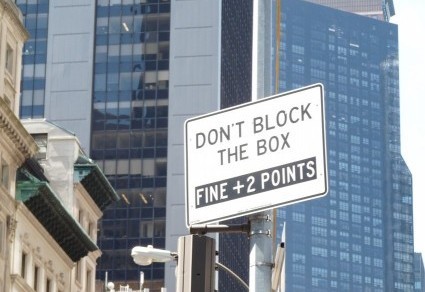No, I’m not talking politics. This is a grammar blog! I’m talking about verb forms employed as nouns or descriptions, adding a dash of information — or, in the case of these signs, misinformation. Have a look:

I appreciate the sentiments, which appeared in one outpost of a national coffee chain, and I enjoy the creative capitalization. The last line of the message was a little alarming, though. Call me old-fashioned, but I prefer to see employees “serving,” not “servicing,” customers. If I need an oil change, I’ll look elsewhere. (I won’t make a pun about the other definition; this is a G-rated post. Besides, a little dictionary research won’t hurt you.)
Next up is this offer:

I’m willing to overlook “toping” charges for my pizza, but not “designed your own salad.” As the sign reads (lacking punctuation, of course), a “personal pizza designed your own salad.” Huh. I can only hope the ingredients of the salad are better than the grammar.
And then there’s this one:

I was thinking about upgrading my shower, but I guess I waited too long. This company “specialized in bathrooms” but now has moved on to bigger and better things. Too bad. I do need someone I can rely on. Perhaps I’ll try this place:

I’ll be charitable and assume that the shopkeeper is busy making sure light fixtures don’t catch fire and has no time to correct the sign. Points for artistry with duct tape, though.
Maybe I’ll turn to this firm:
 If they’re “certified,” they can’t be that bad, right? Don’t ask me what they’re “certified” in (or “of,” as the sign says). At least they’re in NY — well, make that “Ny,” but nothing’s perfect. Not even verbals.
If they’re “certified,” they can’t be that bad, right? Don’t ask me what they’re “certified” in (or “of,” as the sign says). At least they’re in NY — well, make that “Ny,” but nothing’s perfect. Not even verbals.

















 Surely you weren’t planning on ushering guests into a room with a naked table! A four-legged pair of jeans would do nicely for a hip, can’t-be-bothered-to-dress-up dinette set. An evening gown with a very wide skirt saves formal hosts from the embarrassment of an underdressed eating surface. No hint from the shopkeeper about what sort of “table clothes” are available. If the customer isn’t pleased with the styles on sale, “sheets” could possibly preserve the table’s modesty.
Surely you weren’t planning on ushering guests into a room with a naked table! A four-legged pair of jeans would do nicely for a hip, can’t-be-bothered-to-dress-up dinette set. An evening gown with a very wide skirt saves formal hosts from the embarrassment of an underdressed eating surface. No hint from the shopkeeper about what sort of “table clothes” are available. If the customer isn’t pleased with the styles on sale, “sheets” could possibly preserve the table’s modesty.

 The bullet point in front of “house” was odd because there were no other items on the sign, hence no bulleted list. But if I’m opting to tinker with punctuation, I’m going for a comma after “house.” That comma would create a direct address statement appropriate to this holiday season: “House, hold items [so I don’t have to].” See? Shopping-stress relief!
The bullet point in front of “house” was odd because there were no other items on the sign, hence no bulleted list. But if I’m opting to tinker with punctuation, I’m going for a comma after “house.” That comma would create a direct address statement appropriate to this holiday season: “House, hold items [so I don’t have to].” See? Shopping-stress relief!

 In my ignorance I was ready to impose an “unauthorized part of speech” penalty — until I looked up “creative” in the dictionary, which enlightened me to the fact that “creative” can be a noun applied to people who, well, create for a living: writers, artists, composers, and so forth. Apparently I’ve been a “creative” for decades and never knew it.
In my ignorance I was ready to impose an “unauthorized part of speech” penalty — until I looked up “creative” in the dictionary, which enlightened me to the fact that “creative” can be a noun applied to people who, well, create for a living: writers, artists, composers, and so forth. Apparently I’ve been a “creative” for decades and never knew it.







 Do you call the front desk for “boom service,” and if so, how much do you tip the guy who lowers the boom? How do you delivery a “jobsite”? And what does a “boom service” showroom show?
Do you call the front desk for “boom service,” and if so, how much do you tip the guy who lowers the boom? How do you delivery a “jobsite”? And what does a “boom service” showroom show?